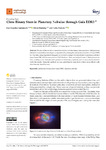Mostrar o rexistro simple do ítem
Close Binary Stars in Planetary Nebulae through Gaia EDR3
| dc.contributor.author | González Santamaría, I. | |
| dc.contributor.author | Manteiga, Minia | |
| dc.contributor.author | Dafonte, Carlos | |
| dc.date.accessioned | 2022-01-03T12:41:00Z | |
| dc.date.available | 2022-01-03T12:41:00Z | |
| dc.date.issued | 2021 | |
| dc.identifier.citation | González-Santamaría, I.; Manteiga, M.; Dafonte, C. Close Binary Stars in Planetary Nebulae through Gaia EDR3. Eng. Proc. 2021, 7, 40. https://doi.org/10.3390/engproc2021007040 | es_ES |
| dc.identifier.uri | http://hdl.handle.net/2183/29301 | |
| dc.description | This article belongs to the Proceedings of The 4th XoveTIC Conference | es_ES |
| dc.description.abstract | [Abstract] The aim of this work is to search for evidence of close binary stars associated with planetary nebulae (ionized stellar envelopes in expansion) by mining the astronomical archive of Gaia EDR3. For this task, using big data techniques, we selected a sample of central stars of planetary nebulae from almost 2000 million sources in an EDR3 database. Then, we analysed some of their parameters, which could provide clues about the presence of close binary systems, and we ran a statistical test to verify the results. Using this method, we concluded that red stars tend to show more affinity with close binarity than blue ones. | es_ES |
| dc.description.sponsorship | Funding from Spanish Ministry project RTI2018-095076-B-C22, Xunta de Galicia ED431B 2021/36, and AYA-2017-88254-P is acknowledged by the authors. IGS acknowledges financial support from the Spanish National Programme for the Promotion of Talent and its Employability grant BES-2017-083126 cofunded by the European Social Fund | es_ES |
| dc.description.sponsorship | Xunta de Galicia; ED431B 2021/36 | es_ES |
| dc.language.iso | eng | es_ES |
| dc.publisher | MDPI | es_ES |
| dc.relation | info:eu-repo/grantAgreement/AEI/Plan Estatal de Investigación Científica y Técnica y de Innovación 2017-2020/RTI2018-095076-B-C22/ES/MINERIA DE DATOS DE GAIA PARA ESTUDIAR LA VIA LACTEA II | |
| dc.relation | info:eu-repo/grantAgreement/AEI/Plan Estatal de Investigación Científica y Técnica y de Innovación 2017-2020/AYA2017-88254-P/ES/NUCLEOSINTESIS Y PROCESOS MOLECULARES EN ESTRELLAS EVOLUCIONADAS: DE (RADIO)ISOTOPOS A NANOESTRUCTURAS MOLECULARES COMPLEJAS | |
| dc.relation | info:eu-repo/grantAgreement/AEI/Plan Estatal de Investigación Científica y Técnica y de Innovación 2017-2020/BES-2017-083126/ES/ | |
| dc.relation.uri | https://doi.org/10.3390/engproc2021007040 | es_ES |
| dc.rights | Atribución 4.0 Internacional | es_ES |
| dc.rights.uri | http://creativecommons.org/licenses/by/4.0/ | * |
| dc.subject | Astrometry | es_ES |
| dc.subject | Binary stars | es_ES |
| dc.subject | Gaia EDR3 | es_ES |
| dc.subject | Planetary nebulae | es_ES |
| dc.title | Close Binary Stars in Planetary Nebulae through Gaia EDR3 | es_ES |
| dc.type | info:eu-repo/semantics/conferenceObject | es_ES |
| dc.rights.access | info:eu-repo/semantics/openAccess | es_ES |
| UDC.journalTitle | Engineering Proceedings | es_ES |
| UDC.volume | 7 | es_ES |
| UDC.issue | 1 | es_ES |
| UDC.startPage | 40 | es_ES |
| dc.identifier.doi | 10.3390/engproc2021007040 | |
| UDC.conferenceTitle | 4th XoveTIC Conference | es_ES |






